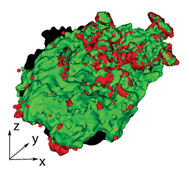Fibrin networks, with and without cells, formed under wild type and hemophilic conditions, have been synthesized, studied and compared. The three dimensional structure of each fibrin network was reconstructed from two-dimensional z-stacks of confocal microscopy sections using novel image analysis algorithms. These images were used to establish microstructure-based models for studying the relationship between the structural features and the mechanical properties of the fibrin networks. The mechanical properties were assessed by analyzing the networks' responses to uniaxial tensile and shear stresses, simulating the impact of blood flow on the fibrin network. The elasticity of the fiber network predicted by the model agrees well with prior experimental data. The change in the fibrin network alignment under applied strain and the elastic modulus values were calculated and compared with prior experimental data obtained in Ryan et al., Biophys. J., 2009, 77, 2813. The model correctly predicts the network alignment under load and the result is in good agreement with the results obtained for small networks in Brown et al., Science, 2009, 325, 741. It was shown that a nonlinear worm-like chain model correctly predicted both the elastic properties of the networks and the alignment of the fibers as the clot sample is stretched.

You have access to this article
 Please wait while we load your content...
Something went wrong. Try again?
Please wait while we load your content...
Something went wrong. Try again?


 Please wait while we load your content...
Please wait while we load your content...